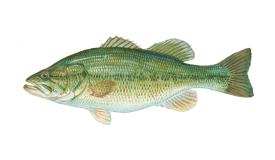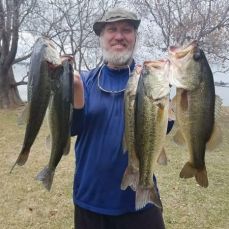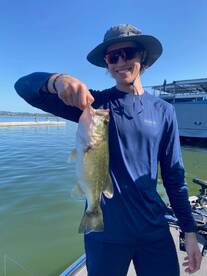Late Summer Patterns
September 21, 2019
Lago Vista
1 photo


Bass (Largemouth)
Trip Summary
Trip Summary
For the past month, I’ve been rotating my clients through several offshore spots where the bass have been feeding and hanging out since mid-summer. We are still throwing two or three of my “go-to” baits on Lake Travis: dropshot with a robo-worm, ¼ oz. shaky head with a zoom speed craw, and ¾ oz. structure jig with a big bug bait! I’ve had to double up the weights on the dropshot to get the bait down in the 30+ foot range to trigger good bites. The extra weight helps to make longer casts and the bait sinks like a rock. The quality bass have mostly been on the very edge and sometimes suspended just below the edge of major offshore, ledges, ridges and walls. In order to trigger more aggressive strikes, drag the bait until you feel it fall off the ledge, then quickly let out more line so the bait continues to fall through the suspended bass!
Texas anglers look forward to the first cooling fronts as the days of summer begin to shorten. These fronts along with the longer, coolers nights, start to drop the waters from the high 80s down to the low to mid 80s. A change in water temp as little as 5 degrees can trigger the bait to start moving towards the mouth of the creeks and away from the offshore structures.
This past week, I started to explore some of the channel swings that lead to the major creeks around the lake. Mostly using the dropshot and shaky head, I had my clients throw as close to the bank as possible. The bait is starting to really stack up in the first few feet of the water column. Within a 50 yard stretch we probably boated 10 bass, with most being keepers! Some of the bigger bass were throwing up tiny shad, which is a good sign for the fall feeding frenzy. Small swimbaits, squarebills and spinnerbaits should start catching good numbers of bass in the next few weeks.
Today’s trip began with some welcome cooler weather, along with some rain. We were delayed for about 30 minutes, but I knew exactly where I wanted to start: the first major channel swing just off the main lake. There was a high school tournament going on, so we had to start in the middle of the area, instead of on the point that I preferred. As usual, I started with a demo cast to show my clients the mechanics of using a spinning rod and a dropshot rig. The rod quickly loaded up! It was a 2.85# largemouth bass which I had to lip because the net was still stowed, and I didn’t want to boat flip it with such a small hook. We proceeded to catch some nice largemouth and several fat Guadalupe bass in that very small area throwing both dropshots and ned rigs.
The main channel swing going into Sandy Creek was our next spot, which was nearly identical to the first. The position to the wind was identical, but the water is about half as deep. We proceeded to boat a few short bass, another largemouth keeper, and many more Guadalupe bass.
The difference from last week to this week was clear. The bait and bass are starting to slowly migrate through the creek channels on the way to their fall feeding grounds. You can still find quality bass offshore, but be sure to spend some time fishing from the offshore hangouts to the secondary points in the major creek arms.
Knowledge of fishing patterns, as well as what’s under the water, are key to catching bass this time of the year. Let Captain Randal with Central Texas Fishing Guide help guide you to success in fishing!
Tight Lines.




